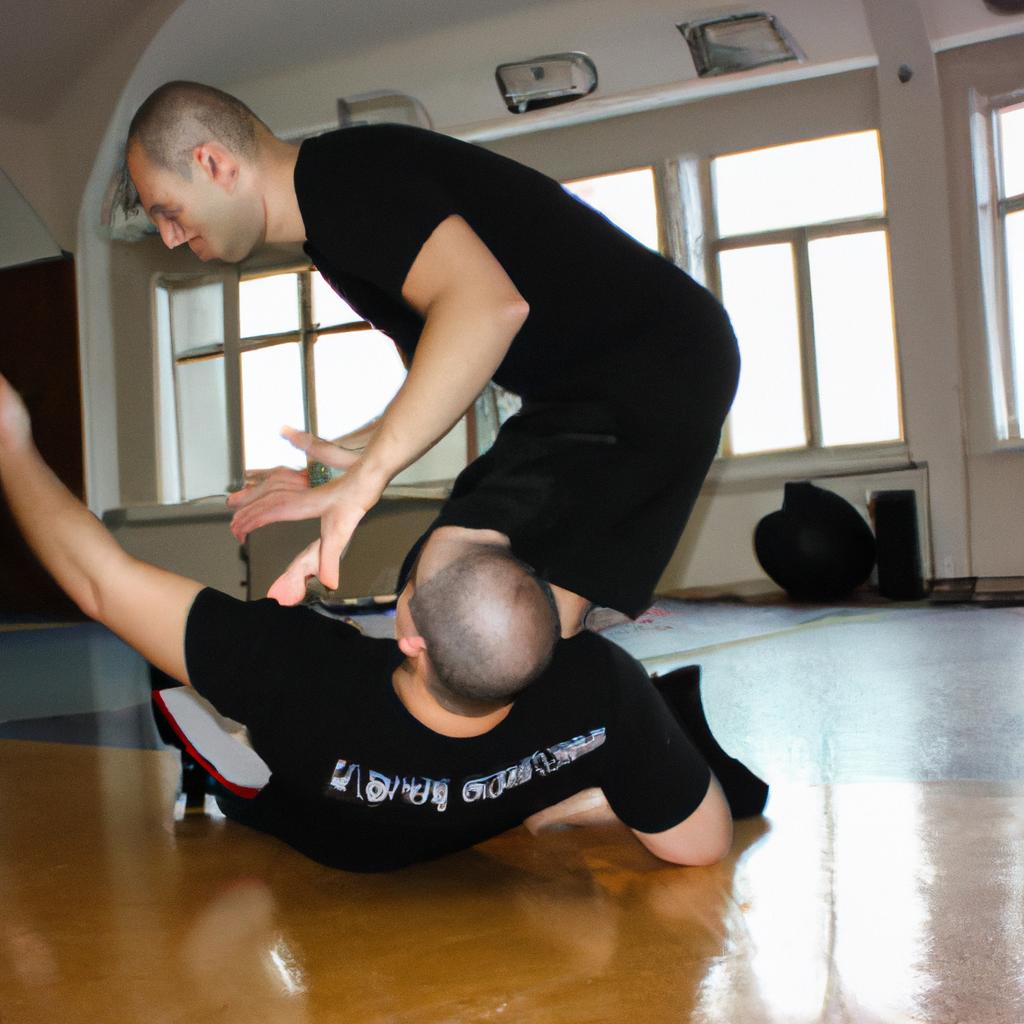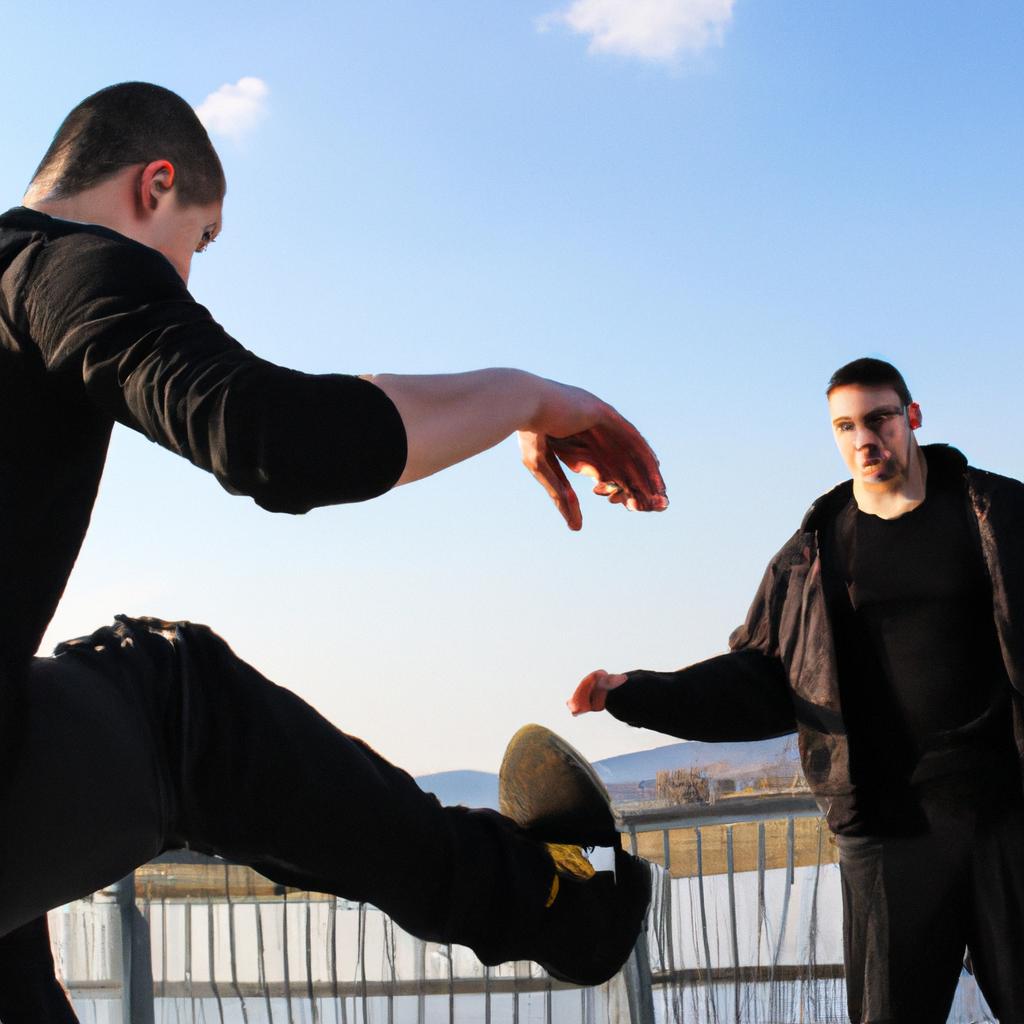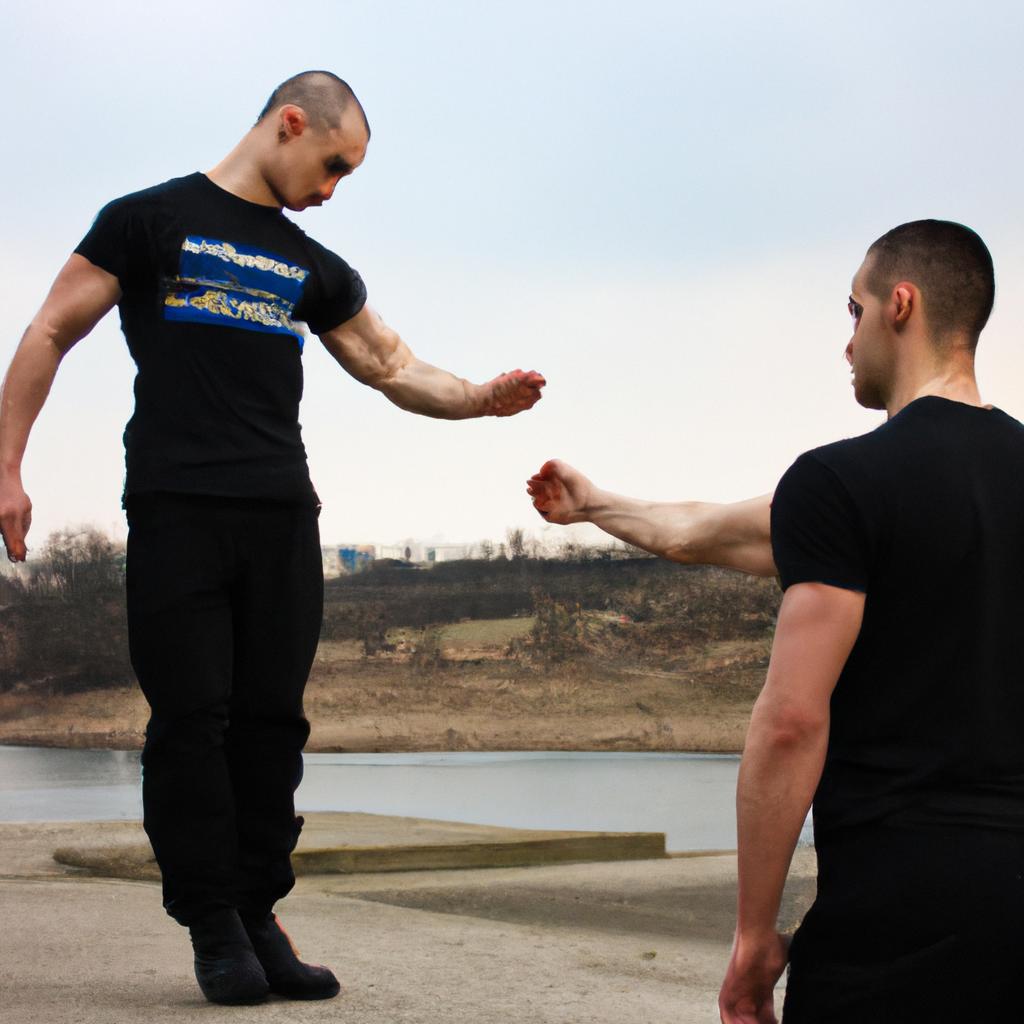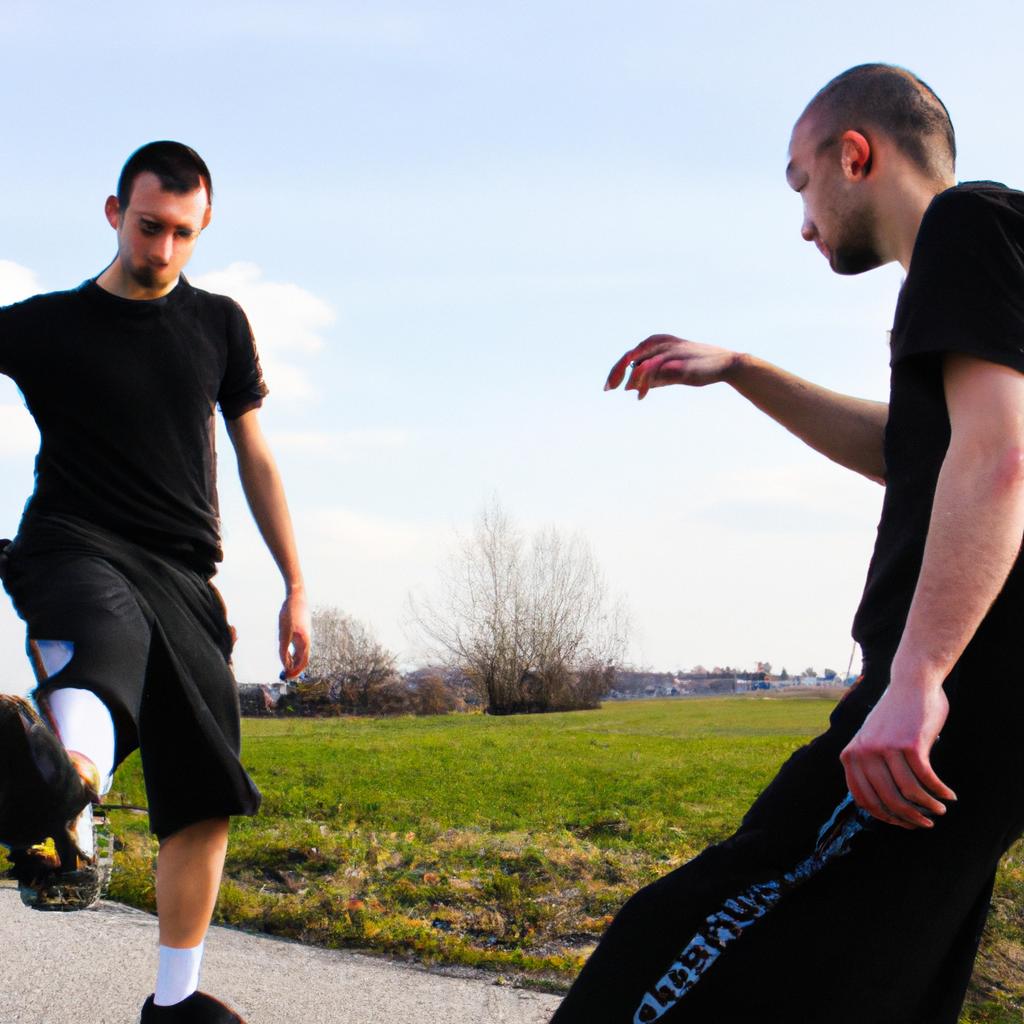The world of mixed martial arts (MMA) is a dynamic and ever-evolving combat sport that combines various disciplines, including striking, grappling, and submissions. Among the numerous martial arts incorporated in MMA, Krav Maga stands out for its unique approach to self-defense techniques. This article aims to delve into the realm of kicking techniques in MMA through the lens of Krav Maga, exploring its principles, strategies, and practical applications.
Consider the hypothetical scenario of an amateur fighter named John who has recently taken up training in Krav Maga. Despite possessing decent punching skills, he finds himself struggling with effectively executing kicks during sparring sessions at his local MMA gym. Intrigued by the reputation of Krav Maga’s versatile fighting system, John decides to explore this particular martial art further to enhance his kicking abilities. By examining the fundamental aspects of Krav Maga’s kicking techniques within the context of MMA, this article seeks to shed light on how practitioners can maximize their effectiveness while incorporating these methods into their arsenal.
In order to achieve a comprehensive understanding of Kicking Techniques in MMA from a Krav Maga perspective, it is important to address key elements such as biomechanics, footwork, and targeting. By analyzing these factors alongside the practical applications of Krav Maga’s kicking techniques, we can provide a comprehensive guide for practitioners looking to improve their kicking abilities in the context of MMA.
Biomechanics play a crucial role in executing powerful and efficient kicks. In Krav Maga, practitioners are taught to generate power from their hips and core, rather than relying solely on leg strength. By using proper hip rotation and engaging the entire body, fighters can maximize the force behind their kicks. Understanding the biomechanics behind each kick allows practitioners like John to optimize their technique and deliver more impactful strikes in MMA.
Footwork is another essential aspect of effective kicking in MMA. Krav Maga emphasizes agility and quick foot movements to create openings for kicks while maintaining balance and defensive positioning. Practitioners are taught to constantly move and adjust their stance, enabling them to attack or defend effectively during an MMA bout. Developing strong footwork skills through Krav Maga training will help John enhance his kicking abilities by allowing him to swiftly change angles, create distance, or close the gap between himself and his opponent.
Targeting is also a critical consideration when incorporating Krav Maga’s kicking techniques into MMA. In contrast to traditional martial arts that may focus on specific areas such as head or body kicks, Krav Maga encourages targeting vulnerable areas that offer maximum impact with minimal risk. This includes striking vital points such as the groin, knee joint, or shin bone against an opponent’s thigh. By understanding these target areas and practicing accurate strikes during training sessions, John can effectively utilize Krav Maga’s kicking techniques in an MMA setting.
To conclude, exploring Kicking Techniques in MMA from a Krav Maga perspective provides valuable insights for practitioners like John who seek to enhance their arsenal within this dynamic combat sport. By understanding the biomechanics behind each kick, refining footwork skills, and targeting strategically vulnerable areas during sparring sessions or fights, John can elevate his kicking abilities and become a more well-rounded MMA fighter. With dedication, practice, and the guidance of Krav Maga principles, John can develop effective and powerful kicks that contribute to his success in the world of mixed martial arts.
The Fundamentals of Kicking in MMA
To understand the nuances and effectiveness of kicking techniques in Mixed Martial Arts (MMA), it is essential to delve into the fundamentals that underpin these martial arts maneuvers. By examining the mechanics, benefits, strategies, and risks associated with kicks, we can gain a deeper appreciation for their role within this combat sport.
One fundamental aspect of kicking in MMA is its versatility. Whether executed from a standing position or while on the ground, kicks provide fighters with various options for offense and defense. For instance, consider a hypothetical scenario where Fighter A finds themselves pinned against the cage by Fighter B. In an attempt to create space and regain control of the fight, Fighter A might utilize a well-timed push kick to keep Fighter B at bay. This example illustrates how kicks serve as valuable tools in managing distance and creating opportunities for strategic maneuvering.
Furthermore, incorporating kicks into one’s arsenal offers several advantages during a match. Firstly, they allow fighters to strike opponents from longer distances compared to punches alone. This increased reach not only facilitates effective offensive strikes but also enables defensive actions such as interrupting incoming attacks before they land. Secondly, certain types of kicks deliver significant impact due to factors like speed and body weight transfer – attributes that make them particularly powerful weapons capable of inflicting damage upon opponents. Lastly, kicks can be used tactically to target specific areas of the opponent’s body, exploiting vulnerabilities or aiming for high-value targets such as the head or legs.
However, it is crucial to acknowledge that there are risks involved when utilizing kicking techniques in MMA bouts. One must possess adequate skill and precision to execute kicks effectively without leaving oneself vulnerable for counterattacks or takedowns. Additionally, improper execution may result in injuries such as sprained ankles or strained muscles if proper form and technique are not maintained consistently.
In summary, understanding the fundamentals of kicking in MMA provides us with insights into its versatility as a combat technique, the advantages it offers during matches, and the risks that fighters must be aware of. By considering these factors, practitioners can develop their kicking skills while making informed decisions about when and how to employ them strategically.
Moving forward into the subsequent section on “Different Types of Kicks Used in Krav Maga,” we will explore specific techniques within this martial arts discipline, shedding light on its unique contributions to MMA’s kicking repertoire.
Different Types of Kicks Used in Krav Maga
Having covered the fundamental aspects of kicking techniques in MMA, we now turn our attention to exploring the various types of kicks employed specifically within Krav Maga. By delving into these unique methods, we can gain a deeper understanding of how this martial art form incorporates effective striking maneuvers for self-defense purposes.
To comprehend the breadth and versatility of kicking techniques utilized in Krav Maga, let us consider an example scenario. Imagine a practitioner finding themselves confronted by multiple opponents within close quarters. In such situations, quick and precise strikes become paramount for gaining a tactical advantage and neutralizing threats effectively.
When it comes to executing kicks in Krav Maga, practitioners are trained to employ a variety of techniques tailored for maximum impact while maintaining stability and balance. Here are some notable examples:
- Front Kick (Teep): This kick is delivered with the ball or heel of the foot and aims at creating distance between the practitioner and their assailant.
- Groin Kick: Targeting one’s opponent below the belt offers an opportune moment for counterattacking or escaping.
- Side Kick: Executed by thrusting the leg sideways towards an attacker’s midsection or legs, this powerful strike can disrupt an opponent’s balance.
- Axe Kick: Delivered vertically downward using either the ball or heel of the foot, this technique emphasizes targeting vulnerable areas such as shoulders or collarbones.
| Kick Type | Description | Target Area | Purpose |
|---|---|---|---|
| Front Kick | Delivered with ball or heel | Midsection | Create distance |
| Groin Kick | Strike below the belt | Groin area | Counterattack/Escape |
| Side Kick | Thrust sideways | Opponent’s midsection or legs | Disrupt balance |
| Axe Kick | Vertical downward strike | Shoulders, collarbones | Target vulnerable areas |
By incorporating a variety of kicks into their arsenal, Krav Maga practitioners can adapt to different scenarios and engage in effective self-defense. These techniques offer versatility and provide options for swift responses when faced with imminent danger.
Understanding the various types of kicks used in Krav Maga lays the groundwork for executing them effectively. In the following section, we will explore proper technique for executing a roundhouse kick, which is a fundamental move within this martial art form.
Proper Technique for Executing a Roundhouse Kick
Imagine a scenario where an individual finds themselves confronted by multiple attackers. In this situation, having effective kicking techniques can be vital for self-defense. Krav Maga, a martial art known for its practicality and efficiency, offers various types of kicks that can incapacitate opponents quickly. Understanding the different kicks used in Krav Maga is essential to mastering this martial art form.
One example of a kick commonly employed in Krav Maga is the roundhouse kick. This powerful strike involves rotating the hip while extending the leg sideways to deliver forceful blows to an opponent’s torso or head. By utilizing proper technique, practitioners are able to generate significant power from their lower body, making it an impactful offensive move.
To further explore the effectiveness of kicking techniques in Krav Maga, let us delve into some key factors that contribute to their success:
- Speed and Precision: Kicks in Krav Maga emphasize both speed and precision. Practitioners strive to execute their kicks rapidly with accurate aim, targeting vulnerable areas such as the groin or solar plexus.
- Combination Attacks: Incorporating kicks into combination attacks enhances their effectiveness. By seamlessly transitioning between punches, knee strikes, and kicks, practitioners maximize their chances of overwhelming attackers.
- Defensive Maneuvers: Kicking techniques also play a crucial role defensively in Krav Maga. They allow practitioners to create distance between themselves and assailants or neutralize incoming threats quickly.
- Psychological Impact: The use of well-executed kicks can have a psychological impact on opponents. Displaying confidence through skilled movements may discourage potential attackers or disrupt their focus during confrontations.
To illustrate these concepts clearly, consider the following table showcasing four common kicking techniques utilized in Krav Maga:
| Technique | Description |
|---|---|
| Front Kick | A forward thrusting kick targeting an opponent’s chest or abdomen. |
| Side Kick | A lateral strike aimed at the ribs, hips, or knees of an attacker. |
| Axe Kick | An overhead downward strike directed towards an opponent’s head. |
| Oblique Kick | A diagonal low-line kick delivered to the knee joint or shin area. |
As we have seen, kicking techniques in Krav Maga are designed for practical application and effectiveness in self-defense situations. They rely on speed, precision, combination attacks, and defensive maneuvers to incapacitate opponents swiftly. In the subsequent section, we will delve into how these kicks play a crucial role in real-life self-defense scenarios.
The Role of Kicking in Self-Defense Situations
Exploring the Martial Arts of Krav Maga: The Role of Kicking in Self-Defense Situations
In the realm of self-defense, mastering effective kicking techniques is crucial for practitioners of Krav Maga. To understand the importance of kicks in real-life scenarios, let us consider a hypothetical situation where an individual finds themselves confronted by multiple attackers. In this scenario, being able to execute precise and powerful kicks can provide a significant advantage when it comes to creating distance and neutralizing threats.
When faced with multiple assailants, one common strategy employed in Krav Maga is utilizing kicks to keep opponents at bay. By employing proper technique and generating substantial force behind their strikes, practitioners are able to create a safe zone around them, preventing adversaries from closing in or launching further attacks. This allows individuals practicing Krav Maga to effectively control the space they occupy during confrontations.
To fully comprehend the role that kicking plays in self-defense situations, it is important to explore its advantages:
- Versatility: Kicks offer a wide range of options for defending oneself against various types of attacks.
- Power Generation: Properly executed kicks can deliver significant amounts of force due to the large muscle groups involved.
- Range Extension: Kicks allow individuals to strike targets that may be out of reach for punches or other close-range techniques.
- Psychological Impact: A well-executed kick can not only cause physical damage but also instill fear and hesitation in potential attackers.
Moreover, understanding the different types of kicks used in Krav Maga enhances combat effectiveness. The following table provides an overview:
| Kick Type | Description |
|---|---|
| Front Kick | Executed using the ball or top part of the foot while moving forward towards an opponent |
| Roundhouse Kick | Delivered by turning on the supporting leg and striking with either the shin or instep |
| Side Kick | Performed by pivoting on the supporting leg and striking with the heel or outer edge of the foot |
| Axe Kick | Delivered from an overhead position, targeting opponents with the bottom of the heel |
In summary, kicks play a vital role in self-defense situations within Krav Maga. By utilizing proper technique and understanding various kick types, individuals can effectively neutralize threats while maintaining control over their surroundings. The next section will explore common mistakes to avoid while executing kicks in this martial art system, ensuring practitioners achieve optimal performance.
Transitioning into the subsequent section about “Common Mistakes to Avoid while Kicking in Krav Maga,” it is essential to remain vigilant during training sessions and correct any errors that may hinder progress.
Common Mistakes to Avoid while Kicking in Krav Maga
Exploring Different Types of Kicks in Krav Maga
In self-defense situations, mastering various kicking techniques is crucial for practitioners of Krav Maga. By diversifying their arsenal of strikes, individuals can effectively defend themselves against potential attackers. One example that highlights the importance of versatile kicking skills involves a hypothetical scenario where an assailant attempts to grab and restrain someone from behind. In this situation, understanding different types of kicks becomes essential as they provide opportunities to create distance and escape.
To enhance one’s proficiency in kicking techniques, it is important to focus on several key elements:
- Balance: Maintaining balance while executing kicks is vital for stability and power transfer. Practitioners should ensure proper weight distribution by keeping the supporting leg slightly bent and grounding themselves with a strong base.
- Speed: Developing quickness in kicks enables swift responses during confrontations. Regular practice enhances muscle memory, allowing fighters to execute powerful yet rapid movements without hesitation or telegraphing their intentions.
- Accuracy: Precision plays a significant role in delivering effective kicks. Training drills that emphasize hitting specific targets (e.g., groin, knee joint) help develop accuracy and increase the likelihood of incapacitating an attacker.
- Retraction: After each kick, retracting the leg quickly minimizes vulnerability and maintains defensive readiness at all times.
To illustrate the significance of these factors, consider the following table showcasing four common kicking techniques used in Krav Maga:
| Kick Type | Description | Target Area |
|---|---|---|
| Front Kick | A straight kick using the ball of foot | Groin or abdomen |
| Roundhouse | A circular kick targeting midsection | Ribs or thigh |
| Side Kick | A lateral kick aiming for vulnerable areas | Knee joint or torso |
| Axe Kick | A downward strike executed with heel | Collarbone or head |
By incorporating these kicks into their training regimen, Krav Maga practitioners can effectively defend themselves in a variety of situations. The next section will delve into specific training drills designed to improve kicking skills in MMA, providing practical methods for honing one’s techniques and enhancing overall performance.
Transitioning seamlessly into the subsequent section about “Training Drills to Improve Kicking Skills in MMA,” it is essential to focus on refining technique and developing strength through targeted exercises.
Training Drills to Improve Kicking Skills in MMA
Section H2: Training Drills to Improve Kicking Skills in MMA
Transitioning from the previous section on common mistakes to avoid while kicking in Krav Maga, it is crucial for practitioners to focus on training drills that can enhance their kicking skills. This section will explore some effective training methods specifically designed to improve kicking techniques in Mixed Martial Arts (MMA).
To illustrate the importance of proper training, let’s consider a hypothetical scenario involving an amateur fighter named Alex. Despite having basic knowledge of martial arts, Alex struggles with executing powerful and accurate kicks during matches. By incorporating targeted training drills into his practice routine, he can significantly enhance his overall performance.
One such drill that has proven beneficial for many fighters is the “Kicking Combinations Drill.” This drill involves practicing various combinations of kicks repeatedly until they become second nature. For instance, starting with a low kick followed by a roundhouse kick and finishing with a spinning back kick. By focusing on fluid transitions between these different types of kicks, fighters like Alex can develop muscle memory and increase their speed and accuracy.
In addition to the drilling technique mentioned above, there are several other ways to improve one’s kicking abilities effectively:
- Partner Pads Work: Practicing kicks using target pads held by a partner allows fighters to simulate real-life scenarios more accurately.
- Shadow Boxing: Engaging in shadow boxing sessions enables fighters to visualize opponents while perfecting their form and technique.
- Strength and Conditioning: Incorporating strength and conditioning exercises specific to leg muscles aids in developing power and endurance necessary for impactful kicks.
- Sparring Sessions: Regular sparring helps fighters apply their newly acquired skills against live opponents, improving both timing and reaction time.
It is important for practitioners always to remember that consistent practice is key when aiming for improvement. The table below summarizes some essential factors for successful kicking skill development:
| Factors | Description |
|---|---|
| Technique | Focus on proper form and execution of different kick types |
| Flexibility | Regular stretching exercises to increase range of motion |
| Balance | Develop core strength and stability for better control |
| Timing | Practice timing kicks with speed and accuracy |
These factors, when incorporated into a training regimen, can help fighters like Alex elevate their kicking skills in MMA. By consistently applying these drills and techniques, practitioners will gradually witness improvement in the power, precision, and overall effectiveness of their kicks.
In conclusion, enhancing one’s kicking skills in MMA requires dedication and targeted practice. Through specialized training drills such as kicking combinations, partner pads work, shadow boxing, and sparring sessions, fighters can develop muscle memory, technique, and situational awareness necessary to execute powerful kicks effectively. Additionally, focusing on essential factors like technique, flexibility, balance, and timing is crucial for long-term growth as a martial artist. With consistent effort and perseverance in training, individuals can significantly improve their kicking abilities in the realm of Mixed Martial Arts.




